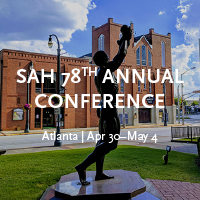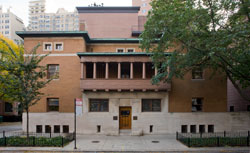-
Membership
Membership
Anyone with an interest in the history of the built environment is welcome to join the Society of Architectural Historians -
Conferences
Conferences
SAH Annual International Conferences bring members together for scholarly exchange and networking -
Publications
Publications
Through print and digital publications, SAH documents the history of the built environment and disseminates scholarshipLatest Issue:
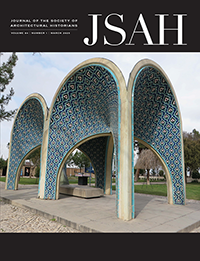
-
Programs
Programs
SAH promotes meaningful engagement with the history of the built environment through its programsMember Programs
-
Jobs & Opportunities
Jobs & Opportunities
SAH provides resources, fellowships, and grants to help further your career and professional life -
Support
Support
We invite you to support the educational mission of SAH by making a gift, becoming a member, or volunteering -
About
About
SAH promotes the study, interpretation, and conservation of the built environment worldwide for the benefit of all
Membership grants you access to exclusive resources and programs and provides support for new research and programs. Compare benefits across all our membership levels and choose the membership level that works for you.
Every Member Receives
- A yearlong subscription to the Journal of the Society of Architectural Historians (JSAH). Choose from digital access only or a combined print and digital subscription.
- On-demand access to the complete JSAH Archive (1941–present)
- Member rates for registration to SAH’s Annual International Conference
- AIA CES credits earned through conferences and study tours
- Eligibility to apply for SAH grants and fellowships
- Access to members-only lectures, virtual meetups, and more
- Connection to peers through 12 topic-focused SAH Affiliate Groups
- Access to more than 200,000 images of the built environment through the SAHARA database
- Access to SAH Commons online scholarly network
- Discount of 50% on JSTOR access with JPASS
- Eligibility to serve on the SAH Board or committees
- Subscription to the SAH Newsletter and Opportunities Weekly Roundup
Membership Levels
SAH Member
Our most popular membership tier offers optimized pricing to help everyone participate affordably in our community. Emerging scholars can apply for a one-year membership grant that helps bridge the gap between the Society's subsidized student memberships and full-cost SAH memberships.
| Rate | Description | Price: Digital | Price: Digital + Print |
| Individual | 12-month benefits for one person | $163 | $173 |
| Joint | 12-month benefits for two people (domestic partners). Each person receives a unique member ID and their own login to the member portal. | $233 | $243 |
| Retired/Emeritus | Discounted individual membership for former professionals on a fixed income | $98 | $108 |
| Reduced | Discounted individual membership for people working independently or at an institution without full-time employment. This includes adjunct and contingent faculty unemployed workers. | $98 | $108 |
| Student | Discounted individual membership for students currently enrolled in an undergraduate or graduate program in architectural history or related disciplines. | $60 | $70 |
| Professional Associate | Discounted individual memberships for groups of professionals working in the same museum, office, or firm. Ideal for architects, research or preservation groups, museum staff, and public design education. | $179 for first member + $103 for each additional member at the same institution | |
Upper-Level Member
Show your support for SAH’s mission by including a tax-deductible donation along with your Individual or Joint print + digital membership. Upper-level members receive all the benefits of a regular membership plus:
- Discount on registration for SAH Annual Conference, rates given below.
- Acknowledgement in four quarterly issues of JSAH, the annual report, and quarterly donor reports
- Membership to Frank Lloyd Wright National Reciprocal Sites Program, with which our headquarters, the Charnley-Persky House is affiliated.
- Early registration access for SAH Study and Excursion tours
| Tier | Donation | Price with Individual Membership | Price with Joint Membership | Discount on Annual Conference Registration |
| Cornerstone | $150 | $323 | $393 | 5% |
| Pillar | $350 | $523 | $593 | 7% |
| Keystone | $500 | $673 | $743 | 8% |
Life and Benefactor Member
Show your long-term commitment to SAH by becoming a Life member. Life members’ dues provide unrestricted funds to support the Society’s mission and continued opportunities for all members. Lock in your price and enjoy the most comprehensive suite of member benefits without the need to renew each year.
Life members receive these additional benefits:
- Acknowledgement in JSAH, annual report, and quarterly donor reports
- Membership to Frank Lloyd Wright National Reciprocal Sites Program, with which our headquarters, the Charnley-Persky House is affiliated.
- Early registration access for SAH Study and Excursion tours
- Specialty membership card
- Free tour of SAH's historic headquarters at the Charnley-Persky House in Chicago, IL
- One complimentary walking tour during SAH Annual Conference, reserved in advance, on a space-available basis.
- Free copy of an SAH Buildings of the United States book of your choice
Current Life Members can enhance their commitment to SAH by becoming a Benefactor through a $5,000 tax-deductible donation.
| Tier | Price | Donation Total |
| Life | $5,000 (one payment or four annual payments of $1,250) | None * |
| Benefactor | $10,000 | $5,000 |
* Life memberships are amortized over a period of 20 years and pay for annual benefits. There is no tax-deductible portion associated with Life membership.
President's Circle
SAH is immensely grateful to the many Life and Benefactor Members who continue to support the Society financially year after year. President’s Circle status recognizes the ongoing commitment these members show.
President’s Circle status is an annual distinction given to all Life and Benefactor members who make gifts to the Society of Architectural Historians totaling $1,000 or more during a given 12-month period. The status is applied to a donor as soon as they have achieved $1,000 in gifts within a single calendar year. The status is valid for 12 months from that date, and the date shall serve as an anniversary by which to renew their President's Circle status with one or more gifts totaling $1,000.
President's Circle members receive special benefits as thanks for their support:
- 10% discount on member-rate conference registration
- Recognition from the podium at SAH Celebrates annual gala
Limited-Access Affiliate
Affiliate membership permits an individual to participate in the activities of one or more SAH Affiliate Groups and the SAH Commons online scholarly network, without access to any other SAH benefits such as JSAH or discounted registration for conferences. Price is $25 per year.
Institutional Subscription
Institutional membership provides a subscription to JSAH and/or JSAH Online for communities of readers at public and academic libraries, museums, schools of architecture, architectural history departments, and other large institutions. Institutional subscribers receive the SAH Newsletter, qualify for discounted Career Center job ads, and member-rate registration for two library staff attending the SAH Annual International Conference.
The University of California Press handles institutional subscriptions on SAH's behalf. Visit the UC Press website to join or renew your Institutional subscription.
| Subscription Type | Price per Year | Additional Benefits |
|---|---|---|
| Digital Only | $693 | |
| Print + Digital - Domestic | $781 | |
| Print + Digital - International | $807 | |
| Sustaining | $881 |
|
Affiliate Groups
SAH Affiliate Groups are comprised of SAH members who share a common, narrowly defined interest, scholarly or otherwise. Participation in Affiliate Group activities is a benefit of SAH membership.
SAH Chapters
SAH has chapters located across the United States. Chapters are independently run organizations that are affiliated with SAH. SAH members can join chapters in their region.
Member Stories
Member Stories: Charlette Caldwell
May 4, 2021
by
SAH News
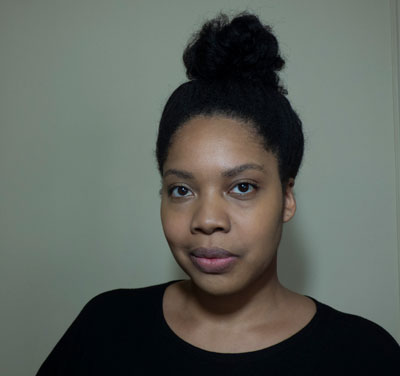 Today's profile is Charlette Caldwell, a Ph.D. student and a Provost Diversity Fellow studying the history and theory of architecture at Columbia University. Charlette has been an SAH member since 2014.
Today's profile is Charlette Caldwell, a Ph.D. student and a Provost Diversity Fellow studying the history and theory of architecture at Columbia University. Charlette has been an SAH member since 2014.Can you tell SAH a little about your background and what interests you most about architectural history?
I have a bachelors in architecture from Syracuse University, but I was always interested in taking architectural history and history classes while completing my undergraduate degree. These interests led me to completing a masters in historic preservation from the University of Pennsylvania and then pursing a doctorate at Columbia University. I think what most interests me about architectural history is uncovering untold stories that are not typically associated with architecture or history in general.
Can you give us a brief summary of your current work?
Currently I’m working on researching and interpreting the role the American Black Church had in the culture of American building in the 19th century. This research takes a vernacular methodological approach that asks questions about the changing cultural values of the built environment rather than deeming something as “commonplace” or “ordinary”. The major outcome I’m working toward with this research is to show Black agency in the built environment that touches on historic and monumental buildings such as Mother Bethel AME in Philadelphia and smaller unassuming places of worship.
That's really interesting. The 19th century spans a watershed in American history—the Civil War—which raises other questions. Are there changes in the establishment and use of Black spaces before and after the war, or do you see consistency and persistent attitudes toward the built environment in the Black community?
This is a good question about consistency and change in Black heritage sites. Although I haven't done the rigorous research for this (haven't quite started the dissertation phase of my PhD!), I do see in other places where I've researched or assisted with preservation efforts that there's consistency. That doesn't mean there are not moments of innovation. Consistency is really something everyone deals with; we adapt only when we need to and keep methods and practices that continue to be sufficient. Where I really see change in building practices is when a community responds to popular trends and adapts them to their unique situations. One really good example of this is Mother Bethel AME in Philadelphia, which I mentioned, where renderings of the different church buildings built on the site corresponded to popular building trends. The current building, built in 1890, is a Richardson Romanesque building. The building has the amenities one would expect for AME liturgy, but also the style reflects popular taste at the time in the United States. So I suppose my answer is that it's more of a both/and and a mix of historical and contextual, if that makes sense. Also, who gets to be a tastemaker? But I suppose that's a question for another day.
and keep methods and practices that continue to be sufficient. Where I really see change in building practices is when a community responds to popular trends and adapts them to their unique situations. One really good example of this is Mother Bethel AME in Philadelphia, which I mentioned, where renderings of the different church buildings built on the site corresponded to popular building trends. The current building, built in 1890, is a Richardson Romanesque building. The building has the amenities one would expect for AME liturgy, but also the style reflects popular taste at the time in the United States. So I suppose my answer is that it's more of a both/and and a mix of historical and contextual, if that makes sense. Also, who gets to be a tastemaker? But I suppose that's a question for another day.
I would imagine most Black churches were sites of sanctuary and agency regardless of building style, but are you finding more differences or more similarities in how these communities valued monumental buildings versus vernacular types?
I see the vernacular more as a process of building as oppose to building types. I think there's still an archaic/elitist assumption of "the vernacular" that labels building practices by some groups of people—which are often race and class based—as "commonplace" or "ordinary" when in actuality, every group of people has building practices that are made of monumental and non-monumental buildings. I think when you also explore the vernacular historically, you'll see that because of the legacy of discrimination, especially in places like the United States, historically marginalized people respond to the built environment very much like everyone else, except there may be those limitations I mentioned before that add uniqueness to their building practices. So I guess this is a long way of saying that there's no such thing as "vernacular" types; the United States in particular (since this is my area of focus) is made up of different types of buildings, engagements, and understandings of architecture. It's more appropriate and inclusive to refer to it as a process of building culture. One architectural historian who I think does a really great job at this is Dell Upton. His American Architecture survey books do a great job at discussing every permutation and iteration of building as happening simultaneously and equally important to our understanding of the built historical past. No one is more important than the other, yet even with this in mind it's best to try to elevate and discuss historically marginalized people such as Black Americans as building monumental and non-monumental structures. You avoid othering folks while recognizing their agency and contributions when you approach history this way.
Along with Dell Upton, do you have other people who have influenced your work or inspired you to study architecture?
In high school I was intrigued by Frank Lloyd Wright, but later I was influenced by historians like Barry Bergdoll and Mabel Wilson. Barry’s book on European architecture was required in my history survey while I was at Syracuse and I came to  appreciate scholars like Mabel as I became more interested in the Black American experience in architectural studies and practices.
appreciate scholars like Mabel as I became more interested in the Black American experience in architectural studies and practices.
My mother is a small business manager at a construction firm in Washington state and she would bring home blueprints that needed review from the project architect. I remember looking through them in our dining room when I was little. That’s the earliest memory I have, but my interest wasn’t really sparked until I began having interest in film and art direction. My father was concerned about my job prospects so I began researching related professional careers and stumbled upon architecture again.
If a layperson asked why we should study architecture and its history, what would you say?
I would say knowing about the past in general is important to learn lessons that could be applied for the future, but architectural history is important especially because it’s something that everyone comes in contact with in their everyday experiences. Everyone has some emotional or cultural attachment to the built environment and it’s crucial to understand that attachment to learn more about people.
When and how did you become involved with SAH and how has the Society enriched your experience in architectural history?
I first became involved with SAH when I started my masters at Penn. It was important to me to learn about the professional opportunities and SAH was one of the top organizations on my list.
Working with other graduate students has been key in my experience with SAH. Serving on the SAH Graduate Student Advisory Committee has shown me more opportunities and possibilities. Also, getting the chance to meet important scholars in our field through attending conferences and talks has been extremely influential in how I work as an architectural historian.
The last year has seen significant changes in our society and in SAH. Do you have a vision for how SAH should evolve in the future, and how do you see yourself as part of that growth?
I think it’s important that SAH responds to historical injustices by elevating historically marginalized voices, but also continuing to instill historical rigor that makes us think deeply about the role the built environment plays in historical scholarship. Also, elevating the work of graduate students could help facilitate a stronger connection among professionals in different stages of their career.
I participated in the first Method Acts Workshop and thought having the opportunity to discuss some interventions I’m hoping to explore with my dissertation was helpful. And despite the moment we’re in, using online platforms allows more people to come into contact with each other, which I thought the workshops did quite well. I do think future workshops could continue discussing archival material and different ways to approach this material. That could be useful for exploring different avenues for research.
Thank you so much for taking the time to answer these questions. I always like to end by asking what advice would you give to a young person considering a career in architectural history or a related field?
I would say take as many history courses as possible, in your interests and outside. This also includes history not explicitly related to architecture as it will expose you to how other historians have been thinking about interpreting the past.
SAH members engage with the history of the built environment through a broad array of specializations, professional fields, and areas of interest. Member Stories is a regular feature that recognizes the expertise and unique experiences of our members.
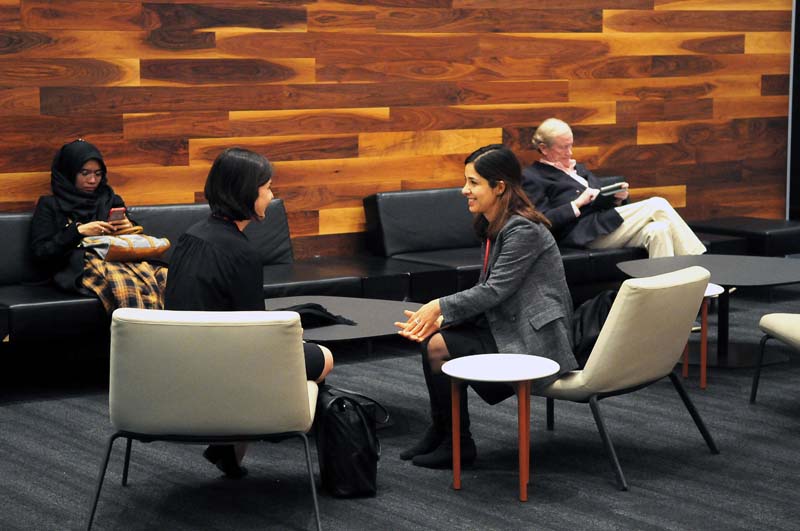
Membership Grants
Emerging scholars can apply for a one-year membership grant that helps bridge the gap between the Society's subsidized student memberships and full-cost SAH memberships.
